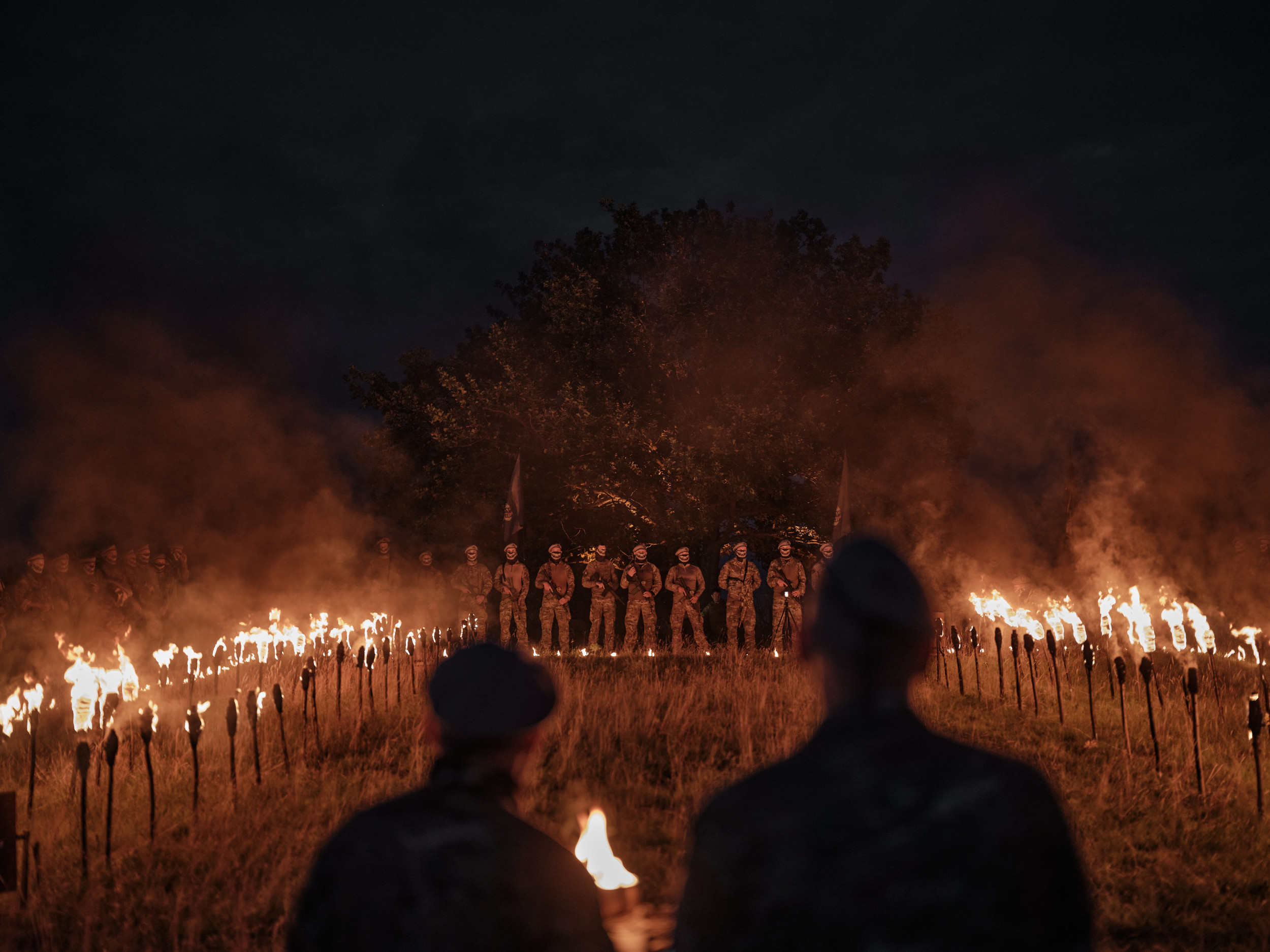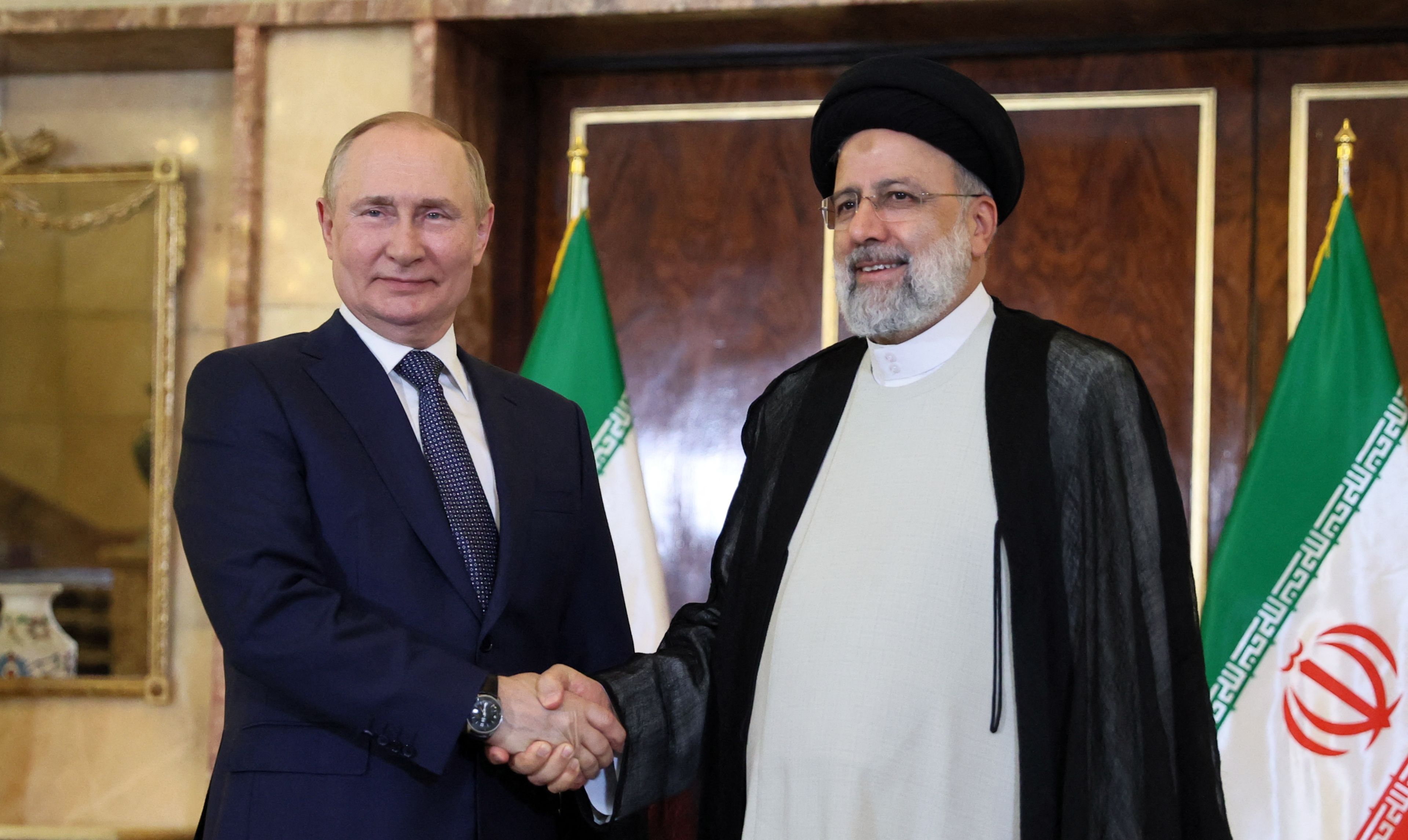While the aftermath of the “12-Day War” between Iran and Israel continues to draw international attention, including from the White House, Russian President
Vladimir Putin
has seized on the opportunity to fuel new momentum for his ongoing war in Ukraine.
As with the conflict in the Middle East, battlefield reports from Europe’s deadliest conflict since World War II are notoriously difficult to verify independently. Yet news from the frontlines indicates recent Russian advances into new regions in central Ukraine, as well as a sizeable buildup of forces near the northeastern regional capital of Sumy.
An analysis conducted by the Agence France-Presse news agency, citing data from the Institute for the Study of War, found that Russian forces had seized more land in June than in any month since last November. Meanwhile, the Ukrainian military faced Sunday what it called the largest-scale aerial assault since Russia first launched the war in February 2022.

Though Moscow’s gains remain relatively limited and incremental, they are persistent. And Putin’s decision to step up the offensive at a time when the White House’s foreign policy focus remains on the Middle East — with President
Donald Trump
now doubling down on efforts to capitalize on the Iran-Israel ceasefire to
seek a truce in Gaza
— may indicate a concerted effort to strengthen the Kremlin’s position should U.S.-mediated talks ultimately manifest over Ukraine.
“You might expect some small offensives while the U.S.’ strategic attention is focused yet again on the Middle East,” Amos
Fox
, retired U.S. Army Colonel serving as fellow at Arizona State University’s Future Security Initiative, told
SnapUpdateNow
.
“Putin might use this perceived distraction as an opportunity to obtain further territory that will prove advantageous for Russia at the negotiating table,” he added.
Bargaining Chips
Officially, Russia’s military objectives remain unchanged since Putin outlined a peace plan in June of last year and later reiterated to
SnapUpdateNow
by Russia’s former ambassador to the U.S. and foreign minister.
The plan would entail Ukraine ceding the largely Russian-held provinces of Donetsk, Kherson, Luhansk and Zaporizhzhia, which were formally annexed by Moscow following an internationally disputed referendum in September 2022, as well as Crimea, seized by Russia and annexed through a similar vote in 2014. Kyiv would also have to abandon its bid to become a
NATO
member and take other steps that have been refused by Zelensky.
Kremlin spokesperson
Dmitry Peskov
reiterated Russia’s commitment to achieving its core wartime aims in a statement issued Tuesday in response to Trump’s special envoy, Keith Kellogg, accusing Moscow of delaying stalling talks toward a settlement.
“We are interested in achieving the goals we have set and the goals that we are trying to achieve during the [Special Military Operation] by political and diplomatic means,” Peskov said in a statement. “Therefore, we are not interested in delaying anything.”
Today, Russia is assessed to have fully taken control of Luhansk, and to have seized between 60 to 70 percent of the other three claimed regions in eastern Ukraine. Crimea has been under full Russian control since 2014.
With Trump having reportedly proposed a freezing of the frontlines as part of his peace plan, Fox argued that Russia’s strategy appeared to be aimed at maximizing gains, particularly if talks appear to be on the horizon.
“My assessment is that Putin is nibbling away at the edges of the front lines to obtain territory that he is happy to give back in the event negotiations to end the war come to pass,” Fox said. “He’s happy keeping the preponderance of the oblasts currently under Russia’s control—Crimea, Luhansk, Donetsk, Kherson, and Zaporizhzhia—while giving back small portions of occupied Ukraine that carry little-to-no value to Putin’s policy.”
“My assessment is that Putin’s obtained what I call his ‘minimal acceptable outcome,’ that is the Donbas, the land bridge to Crimea, and Crimea,” Fox added. “If he didn’t have that, they’d still be fighting hard to obtain that territory. As that territory is now nominally Russian, he’s okay if the war comes to a close.”
Assessing Costs
Fox argued that Russia, despite suffering major losses, appeared to be leveraging its manpower advantage in order to sustain incremental territorial gains.
“Russia appears to be fully engaged in the cat-and-mouse game with countering and employing drones and overcoming Ukrainian precision strikes,” Fox said. “However, Russian strategy is still firmly rooted in mass, that is, just more troops and combat weapons systems, regardless of their quality, to overcome and persist against Ukrainian technological advantages.”
“As horrendous as it sounds to most ears, Russia’s strategy of persistent mass is working for them, if one views ‘winning’ and ‘losing’ at least in part, through the lens of territorial control,” he added. “Considering Putin’s interest in denationalizing Ukraine, territorial control should certainly be one of the categories that onlookers use to measure strategic success and failure, for either side, in the war.”
Dylan Payne Royce, research fellow at the National Research University Higher School of Economics’ School of International Affairs in Moscow, argued that the lack of official sourcing on the losses of either side continues to obscure the true cost of the war in terms of manpower.
He said it was Ukraine that had turned to “draconian methods” of seeking manpower through draft enforcement, while, “for Russia, aside from the September 2022 mobilization, recruitment has been entirely of volunteers.” At the same time, “Russian forces have generally been advancing at a modest but substantial pace since around last spring.”
“Combined,” Royce told
SnapUpdateNow
, “these things suggest that Russian forces are performing significantly better than their opponents on the battlefield.”
Frederick Kagan, senior fellow and director of the Critical Threats Project at the American Enterprise Institute, painted a more complex picture, one in which Ukraine continued to demonstrate a formidable prowess in undermining Russian strengths and exploiting enemy weaknesses.
“The Russians are not particularly close to achieving their stated objectives, are not plausibly going to achieve their stated objectives unless thing changes very dramatically, and the Ukrainians are increasingly finding ways to offset their advantages,” Kagan told
SnapUpdateNow
.
He said that Russian gains have been significantly slowed by shortages in armor and the vulnerability of tanks to Ukrainian drone strikes, forcing Russian troops to advance largely at a foot’s pace.
“So, on the one hand, they have adapted their tactical approach to take account of and mitigate their problems with armor, but that means their advance is fundamentally limited to three miles an hour,” Kagan said, “which is how our calculations show that at the current rate of advance, it will take Russia about a century to conquer the rest of Ukraine.”
And despite this pace, total victory rather than a partial win was Putin’s ultimate goal, according to Kagan.
“Putin thinks that he can continue to push forward with these slow, grinding advances for as long as it takes, and that eventually Western support for Ukraine will collapse, and Ukraine will collapse, and he will be able to defeat it completely,” Kagan said. “That’s our assessment of Putin’s current strategic calculus.”
“That strategic calculus is fed by the fact that the Ukrainians have not shown the ability since 2023 to conduct a significant counter offensive and retake territory from Putin,” he added. “So, Putin’s basic approach is, however small the gains are, they’re incremental, and he gets to keep whatever he takes, and so he’s just going to keep pushing until he either takes it all or Ukraine collapses.”
Fates Intertwined

Ultimately, what’s in store for the tinderbox in the Middle East may have a profound influence on the course of the conflict in Ukraine. Already, direct ties exist between the two theaters.
Moscow and Tehran are longtime partners who deepened their strategic pact in January and Shahed-style suicide drones licensed from Iran have become a staple of Russian strikes across Ukraine.
Russia has also a vested interest in Iran’s stability beyond the conflict in Ukraine.
While Putin has publicly affirmed that his nation’s recent deal with Tehran fell short of a mutual defense treaty, and that Iranian officials had declined offers to acquire advanced air defense equipment, the potential loss of another key partner in the Middle East just months after the fall of longtime Syrian President
Bashar al-Assad
could prove devastating
to Moscow’s influence in the region.
When the U.S. intervened directly against Iran, conducting unprecedented strikes against three key Iranian nuclear facilities under Trump’s orders, Putin condemned the move as an “unprovoked act of aggression.” The following day, Iran’s top diplomat traveled to Russia for talks.
Meanwhile, as Iran-Israel tensions boiled over, Defense Secretary
Pete Hegseth
confirmed that the
Pentagon
had diverted anti-drone systems from Ukraine to the Middle East.
On Tuesday, the White House confirmed to various media outlets that a number of U.S. shipments to Ukraine in line with a Department of Defense review.
“This decision was made to put America’s interests first following a DOD review of our nation’s military support and assistance to other countries across the globe,” White House spokesperson Anna Kelly said in a statement cited by the Associated Press.
“The strength of the United States Armed Forces remains unquestioned — just ask Iran,” she added.
Update 7/1/2025 8:43 p.m. ET: This article has been updated to include new information regarding the Trump administration’s policy toward Ukraine.
Related Articles
- Map Reveals Scale of Russia’s Summer Offensive Against Ukraine
- Trump Reacts as Russia Deploys 50K Troops Near Ukraine
- Ukraine Sees Mixed Results at the 2025 NATO Summit | Opinion
- What F-16 Loss Means For Ukraine’s Air Power
Start your unlimited SnapUpdateNowtrial
